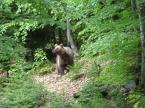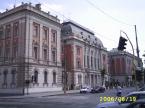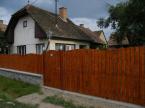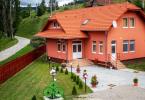Information
WIKI REFRESH Roşia Montană (German Goldbach; Hungarian: Verespatak) is a commune in the Apuseni Mountains, in the Alba County, in the west-central Romania. It is located in the Valea Roşiei, through which Roşia River flows.
The Roşia (Red) River is high in minerals, especially iron which gives its red colour, hence the name of the town in Romanian and Hungarian (which literally means "Red Creek").
The town was founded by the Romans during the rule of Trajan as a mining town, with colonists from Illyria. It was known as Alburnus Maior, the earliest document that uses this name being a wax tablet dated 6 February 131. Many of archeological findings can be now in the "Mining Museum" (Muzeul Mineritului) of Roşia Montană.
Population
According to the 1992 census, the Roşia Montană commune had a population of 4146, of which 3808 Romanians, 228 Roma (Gypsies), 104 Hungarians and 6 Germans. In 1910 it had a population of 2907, of which 1481 Hungarians and 1412 Romanians.
Mining project
The place became famous after a Canadian company, Gabriel Resources (which has no mining experience and founded by Frank Timiş), wanted to mine for gold using gold cyanidation, thus polluting the area around five mountains with cyanides (which would last in the environment for hundreds of years), as well as destroying the archeological remains of the Roman town Alburnus Maior. In all, the company it would use an area of 42.82 km² and it expects to extract 300 tons of gold and 1600 tons of silver.Whether Gabriel Resources company would get the environmental permits and start their works is expected to be decided by the Romanian Government in the second half of 2006.
Effects to the environment
The project would consist in the building of largest open-pit gold mine in Europe (the whole area needed for the project is 16 km²) and in order to be economically feasible, the builder of the project would have to carve the Roşia Montană valley in four open-pit mines, while another valley, Corna, would have to be transformed in a 6 square kilometre cyanide storage pond, with a 180 metre high dam. In all, the project would generate 196 million tons of cyanide waste.There was a precedent of a disaster created by a gold mining company using cyanides in Romania, in Baia Mare, where a cyanide spill in 2000 polluted the waters of Tisza and the Danube which lead to the killing of 1200 tons of fish and to the contamination of the water supplies of 2 million people. Since 1990, there were about 30 such incidents throughout the world, each having serious influence to the environment.
The report released by the Romanian Academy said that the method used for sepparating gold from cyanide is against EU environmental regulations as any large-scale use of cyanides in mining is forbidden.
Dissenting views say that the mining project will clear up two thousand years of mine workings which are prone to flooding and are polluting the local water supply. For example the local environment has 110 times the legal limit of zinc.
Effects to the local economy
In order to begin the project, 2150 people would have to be involuntarily displaced and 900 houses and 10 churches would have to destroyed. The project would have a staff of about 250 people (including foreign experts) for about 15 years, according to the estimations of the International Finance Corporation.As Roşia Montană is considered a "less favoured area" (zonă defavorizată), the company would not have to pay duty and VAT for any of the imports and low profit tax, so, in all the Romanian state would get an insignifiant part of the profit: 2% of the $3 billion.
The Romanian Academy also argues that local pollution would detract any other companies from investing in the area and that the touristic industry of the whole region would be affected.
Again in dissent - it should be noted that the Romanian government owns 20% of shares in the mining project - and thus will automatically get 20 per cent of profits in the mine. See reference 2.
Effects to the archaeological site
The remains of the Roman town, Alburnus Maior, would also have to be destroyed in order to complete the project. The remains of Alburnus Maior are of Roman mining town and it includes from ancient industrial facilities, such as Roman mining galleries to remains of temples, baths, houses, etc, being described by UNESCO as "a unique archaeological complex of Roman mine galleries".The mining company did invested $6 million to do a three-year archaeological investigation, but it is certain that it is not enough time for the archaeologists to investigate it completely before its demolition.
Public reaction
Almost all the press was against the project as well as Romania's most important archeologists and historians, the Romanian Academy, the Romanian Orthodox, Catholic and Unitarian churches.Also opposed to the project are various international groups, including the World Bank, Greenpeace, the European Federation of Green Parties as are over a thousand archeologists, historians and classicists from all over the world.
However, in August 2005, the Canadian government announced that it supports Gabriel Resources' project, while in October 2005, Miklos Persanyi, the Hungarian Minister of Environment announced that the Hungarian government strongly opposes the project. In 2005, Gabriel Resources began a new media campaign for the project. Some publications, such as Academia Caţavencu and the Romanian edition of National Geographic stopped publishing ads for Gabriel Resources after protests from ecological organizations. These organizations also complained to the National Broadcasting Council saying that the ads are "deceitful", but this was dismissed by the Council.
British actress and campaigner Vanessa Redgrave spoke out against the project as part of her speech for the acceptance of the lifetime achievement award at the Transilvania International Film Festival. The mining company retaliated with a full page advert in The Guardian, in which they argued that their mines would replace "2,000 years of poor mining practices" and actually improve the situation of the local environment. <ref>BBC, "Redgrave in Romanian mine rumpus", 23 June 2006</ref>
FânFest
In the summers of 2004 and 2005, several NGOs organized at Roşia Montană a music festival called "FânFest" (Fân means "Hay" in Romanian) to which many important Romanian bands and singers participated, including Ada Milea, Luna Amară, Shukar Collective Timpuri Noi, Viţa de Vie, Zdob şi Zdub. About 10,000 people participated in the 2005 edition.In 2006, the 3rd festival is organized, between 25 and 27 August. FânFest at Roşia Montană will be welcoming visitors from all over the country to celebrate life and the environment through culture and music.
FânFest will continue its tradition of being a free open air musical festival offering live entertainment. The main stage will welcome groups performing rock, jazz, folk, reggae and world music. All artists performing are doing so pro bono in aid of the Save Roşia Montană campaign and to celebrate artistic diversity and multiculturalism.
Over the three day FânFest event, visitors will be able to choose from a large range of cultural, environmental, musical and outdoor activities as well as being able to participate in various workshops.
For the first time this year FânFest will house a larger tent with a second stage exclusively dedicated to cultural, environmental and social activities. This "Alternative Activity Tent" will host theatre and dance performances, video projections as well as workshops and presentations.
Notes
<references/>
References
- Financial Times column, Gold is Not Enough. April 08, 2004.
- nodirtygold.org: Roşia Montană
- Risk analysis made by the "Alburnus Maior" NGO
- Report about Roşia Montană, of the Academia Română
External links
- alburnusmaior.ro: National Research Program "Alburnus Maior"
- rosiamontana.org: Locals against the mining exploitation proposed by Gabriel Resource
- rmgc.ro: Roşia Montană Gold Corporation
- eurasischesmagazin.de: Der Fluch des Karpaten-Goldes (with photo gallery)
- drumulaurului.ro: Green way in Roşia Montană, tourist information(photo gallery)
- fanfest.ro: the music festival organized by the environmentalists
- portal of Apuseni mountains/Erdélyi Szigethegység with links to Rosia Montana
- 1st Communication Summer University: Torockó - Verespatak/Rimetea - Rosia Montana
- www.goldenmyths.com Website critical of environmentalist opposition to new gold mine

 English
English









